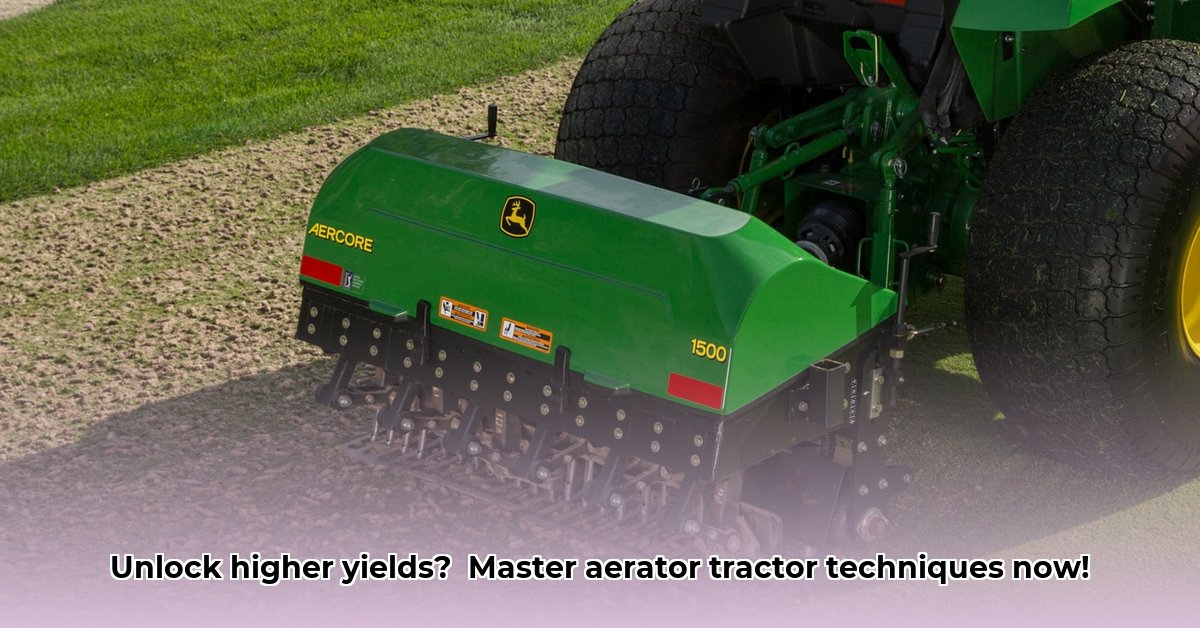
Aerator Tractor Techniques: Boosting Your Yields
Aerator tractors are powerful tools that significantly improve harvests and contribute to healthier land. Choosing and using one effectively requires understanding your soil and the equipment. Don't underestimate the impact – even smaller plots benefit significantly from proper aeration. For more in-depth information, check out this helpful resource: Aerator Tractor Guide.
Understanding Your Soil: The Foundation of Success
Healthy soil is crucial for optimal crop growth. Think of it as a sponge: compacted soil is a squeezed-out sponge, unable to absorb water and nutrients effectively. This leads to poor water penetration, stunted root growth, and reduced yields. Aerator tractors remedy this by breaking up compacted soil, creating pathways for water and nutrients to reach plant roots. A well-aerated soil structure increases yields, while compacted soil often results in a significant yield reduction. What are your current yields? Are they meeting your expectations?
Choosing the Right Aerator Tractor: A Perfect Match for Your Needs
Selecting the right aerator depends on your budget, field size, and soil type. What works well on sandy soil might be ineffective on heavy clay.
Two main types of aerators exist:
Solid-tine aerators: These efficiently break up compacted soil across large areas. They are generally more budget-friendly, ideal for extensive farms.
Core aerators: These remove small soil cylinders, creating larger holes. This dramatically improves aeration, particularly beneficial for soils with significant thatch buildup (a layer of dead grass). While more expensive, core aerators are perfect for smaller plots needing intensive treatment or for turf management.
Here's a comparison:
| Feature | Solid-Tine Aerator | Core Aerator |
|---|---|---|
| Cost | Lower | Higher |
| Soil Type | Suitable for various soil types | Excellent for heavy clay, thatch-prone soils |
| Area Coverage | Larger areas | Smaller areas |
| Thatch Removal | Limited effectiveness | Highly effective |
| Depth of Action | Typically less deep penetration | Deep penetration creating larger holes |
Mastering Your Aerator Tractor: A Step-by-Step Guide
Step 1: Pre-Flight Check: Assess soil moisture; avoid aerating when soil is too wet (causing clogging) or too dry (hindering penetration). Clear the area of debris. A pre-aeration soil test can help determine the extent of compaction and guide treatment strategy.
Step 2: Secure Attachment: Carefully attach the aerator to your tractor, double-checking all connections. This step is crucial for safety. Neglecting this may result in severe safety concerns.
Step 3: Depth Adjustment: Set the aeration depth according to soil type and crop. Consult your manual. Deeper penetration addresses significant compaction.
Step 4: Initiate Aeration: Begin slowly, gradually increasing speed. Steady, consistent movement is key.
Step 5: Overlap for Even Coverage: Overlap passes slightly for even aeration. Uneven coverage diminishes efficiency.
Step 6: Routine Inspection: Monitor the aerator for damage, blockages, or unusual vibrations. Regular inspection leads to better safety and efficiency.
Keeping Your Aerator Tractor in Top Shape: Maintenance and Troubleshooting
Regular maintenance is crucial.
- Cleaning: Clean thoroughly after each use, removing soil, debris, and plant material.
- Lubrication: Regularly lubricate moving parts (consult your manual).
- Inspection: Regularly inspect for wear and tear. Address issues promptly.
Consult your manual for troubleshooting. If problems persist, contact a qualified mechanic.
Timing is Everything: When to Aerate
The optimal aeration time depends on your climate and crops. Spring aeration addresses winter compaction. Fall aeration helps remove thatch. Consider crop growth stages when planning your aeration schedule. Ongoing research continually refines our understanding of optimal timing. When did you last aerate your fields? What were the results?
Aeration's Long-Term Impact: A Sustainable Approach to Farming
Regular aeration promotes sustainable farming. Improved water infiltration reduces runoff. Better nutrient uptake reduces the need for synthetic fertilizers. Healthier soil structure enhances root growth and disease resistance. The long-term benefits – improved soil structure, reduced chemical reliance, and increased yields – far outweigh the initial costs. Dr. Emily Carter, Soil Scientist at the University of California, Berkeley, states, "Aerator tractors offer a significant pathway towards more sustainable agricultural practices by improving soil health and reducing the environmental impact of farming." What sustainable practices do you currently employ? Is there a synergistic effect that aeration would bring?
Understanding Soil Compaction: The Silent Thief of Yields
Compacted soil restricts water and nutrient infiltration, hindering root development and reducing yields. Aeration alleviates this, creating channels for better water penetration and improved root growth.
Choosing Your Aerator: Solid-Tine vs. Core Aeration
Heavy clay soils might benefit from solid-tine aerators. Lighter soils may benefit more from core aerators. Factor in your budget and plot size when choosing your equipment.
Aerator Tractor Operation: A Step-by-Step Guide
- Pre-Aeration Assessment: Inspect the field, identify areas needing attention, and choose correct settings.
- Safe Operation: Familiarize yourself fully with the equipment and use safety gear.
- Aeration: Proceed slowly and evenly, overlapping passes.
- Post-Aeration Inspection: Inspect the field and make adjustments as needed.
- Maintenance: Thoroughly clean the aerator after each use.
Best Practices for Year-Round Lawn Aeration for Sustainable Agriculture: A Seasonal Approach
Timing is vital. Spring aeration combats winter compaction. Fall aeration prepares the soil for winter. In warmer climates, aeration might be beneficial year-round. Regular monitoring is essential.
Maintenance and Troubleshooting
Regular maintenance is crucial for maximizing your aerator's lifespan. Inspect tines/cores, lubricate moving parts, and consult the manual if problems arise or contact a qualified mechanic.
The Environmental Impact of Aeration
Aeration, within a sustainable agricultural strategy, enhances environmental benefits. It reduces excessive irrigation needs and helps prevent soil erosion.